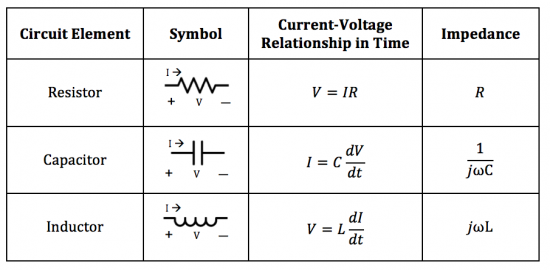Difference between revisions of "Impedance Analysis"
(→Overview) |
(→Overview) |
||
| Line 4: | Line 4: | ||
=Overview= | =Overview= | ||
| − | For analyzing the frequency response of circuits with various components, it is convenient to think of a generalized form of resistance, or opposition to current flow, known as impedance (<math>Z</math>). Clearly, we know that a resistor's resistance to current flow is known by its resistance. Although capacitors and inductors don't technically have a "resistance" value, they do resist current flow in their own ways and we can call those their respective impedances. Thus, Ohm's law applies not only to resistances, but to impedances as well: <math>V = I Z</math> | + | For analyzing the frequency response of circuits with various components, it is convenient to think of a generalized form of resistance, or opposition to current flow, known as impedance (<math>Z</math>). Clearly, we know that a resistor's resistance to current flow is known by its resistance. Although capacitors and inductors don't technically have a "resistance" value, they do resist current flow in their own ways and we can call those their respective impedances. Thus, Ohm's law applies not only to resistances, but to impedances as well: |
| + | {| class="wikitable" style="margin: 1em auto 1em auto;" | ||
| + | |align="center"|<math>V = I Z</math> | ||
| + | |} | ||
| + | where <math>V</math> is the voltage drop across the components of interest, <math>I</math> is the current, and <math>Z</math> is the impedance of those components. | ||
Revision as of 19:38, 21 July 2016
Overview
For analyzing the frequency response of circuits with various components, it is convenient to think of a generalized form of resistance, or opposition to current flow, known as impedance ($ Z $). Clearly, we know that a resistor's resistance to current flow is known by its resistance. Although capacitors and inductors don't technically have a "resistance" value, they do resist current flow in their own ways and we can call those their respective impedances. Thus, Ohm's law applies not only to resistances, but to impedances as well:
| $ V = I Z $ |
where $ V $ is the voltage drop across the components of interest, $ I $ is the current, and $ Z $ is the impedance of those components.
The table below indicates the impedance values for different circuit elements. Here, $ j $ is the imaginary number and $ \omega $ is frequency in units of radians. Recall that $ \omega = 2 \pi f $, where $ f $ is frequency in units of Hz.
Derivation
link to review of complex numbers

